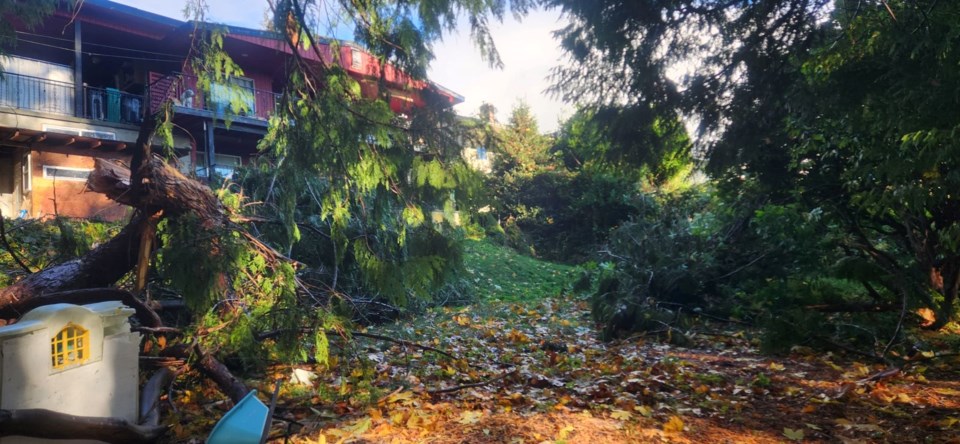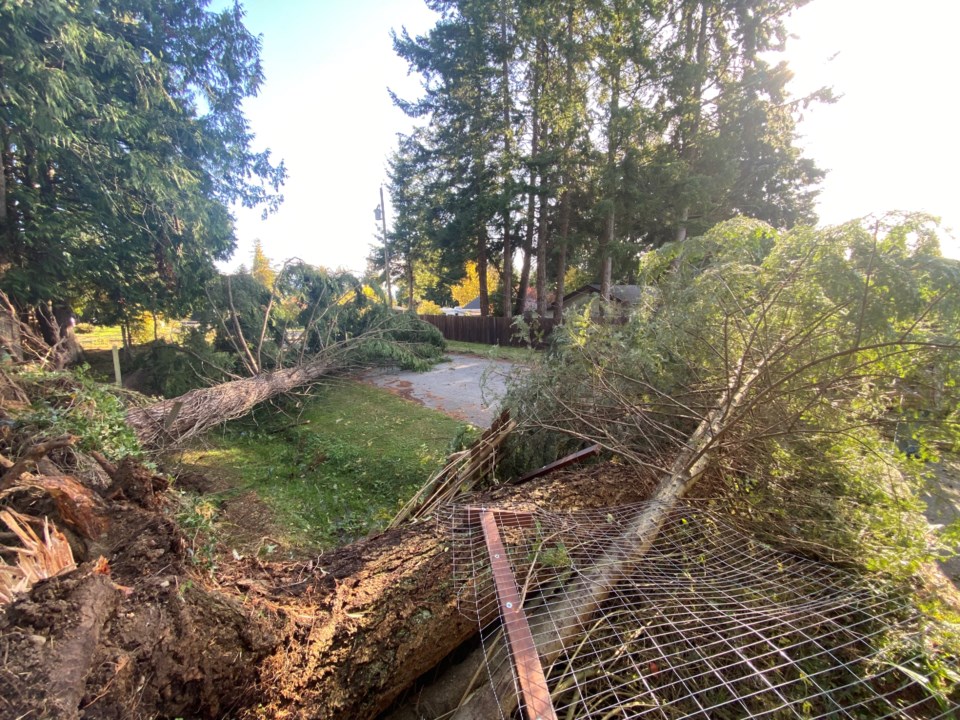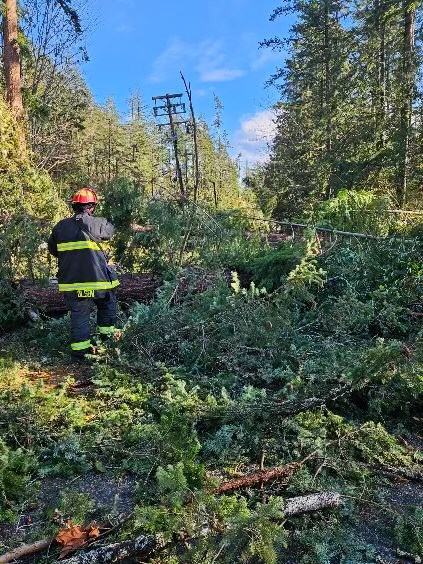It sounded like a train was coming through the trees in Lithena Gibson’s West Sechelt backyard at around 11 a.m. Monday morning, and then the trees started falling. “I couldn’t decipher what trees were falling. There were so many trees coming down,” she said.
Luckily, the one tree that fell on Gibson’s roof just dented the railing and she and her husband were OK, though shaken up.
Meanwhile, all across the Coast, urged by strong, shifting winds from the north and south, trees toppled across roads, onto power lines and onto homes. In Halfmoon Bay, where a weak tornado hit, residents described the scene like a bomb had gone off, flattening trees.
Trees fallen across Highway 101 and downed power lines by Redrooffs Road caused a five-hour highway closure and even longer power outages. But that was far from the only road closure or outage.
At one point Monday, more than 12,000 Sunshine Coast customers were without power; mid-day Tuesday, more than 4,000 people still had not had power restored as BC Hydro responded to damage across the Lower Mainland and Vancouver Island. At 2 p.m. Wednesday, more than 700 Sunshine Coast customers were still without power.
As of mid-day Tuesday, Stacy Rumba, operations manager of restoration company First Response DKI, said they were responding to “close to 20 tree impacts” to homes within the previous 24 hours. She said it was the most calls for fallen trees they’d received. “We often will get an influx of water damage claims if we have some torrential rains. But in terms of trees falling, this is the most we’ve ever seen,” she said.
Rumba hadn’t heard of any injuries at the jobs they’ve had so far. They saw a lot of broken trusses and destroyed roofs. Over the next week, they’ll be securing the buildings so they can be ready for when the rains return. “It’s just triage right now, trying to secure all the buildings that were affected,” she said, also noting the particularly poor timing of the damages, heading into winter.
Though some of the most dramatic scenes of fallen trees came from Halfmoon Bay, trees blocked roads and downed power lines from Pender Harbour to Port Mellon, and the calls to DKI and fire departments were similarly spread out.

EOC activated
Sunshine Coast Regional District activated a Level 1 (monitoring) emergency operations centre (EOC) at 4 p.m. Monday to support communication and coordination in response to the Coast-wide damage. It was in touch with BC Hydro, BC Ambulance, RCMP, Emergency Support Services, local fire departments, Search and Rescue, Capilano Highways and Emergency Management and Climate Readiness – South West PREOC. However, the EOC stood down less than 24 hours later as the situation shifted from emergency response to recovery.
EOC director Rob Michael called the damage to the Coast “widespread,” but also noted there were no injuries reported to him. “I think we got off very lucky that way.”
Asked if anyone had lost their home, DKI’s Rumba said there is just one location that may be a tear down, but it would be up to engineers to dictate whether or not that’s the case. "It was just undersized beams, things like that, where you're not getting the same building code that you would have in 2024,” she said. “Older buildings, cabins, things like that, they can't take the same type of hit.”
Power lines
Of particular concern for EOC director Michael on Tuesday, were reports of people moving barricades, cones and flagging tape. “And that’s really disheartening,” said Michael. “Residents should stay clear of power lines and not remove any barriers or cones placed by emergency responders.”
The danger of downed power lines was illustrated in Gibsons. When Richard Lund returned to his Rosemund Lane home off Pratt Road Monday evening, he had to access the house through a neighbour’s yard as two large trees and three small ones had fallen on the property and across the street, taking down power lines as they went.
The street had been cordoned off, the handful of homes in the cul-de-sac cut-off from the main road by the trees, and the lines were lying broken on the road. But some time after Lund got home, the power lines re-energized.
“Suddenly the whole street just started sparking, and then red flames were shooting up, and smoke,” Lund described. “It was about 15 minutes of fire, I got really scared because there’s a transformer across the street and I was worried that it was going to blow.”
The Gibsons and District Volunteer Fire Department attended the scene, the power was shut off and the fire was extinguished. Michael, who is also the Gibsons fire chief, pointed to this as a reason to steer well clear of power lines, as they can re-energize suddenly, causing injury or death. Explaining what happened, he said, “One of the feeder lines was re-energized after some repairs...But somewhere down the distribution line, they [had] a tree that had taken down some wires, which [became] re-energized.”

No weather alert
While the Lower Mainland received a special weather statement for strong winds and heavy rain, the Sunshine Coast did not, and the storm caught many by surprise. This included DKI’s Rumba. “I feel like we generally have our finger on the pulse with weather systems, because it really affects our work, but we really did not know that was coming,” she said.
Environment and Climate Change Canada meteorologist Ken Dosanjh said Tuesday the Coast received strong winds from the south-southeast and then they shifted to the north. That said, in most areas, the Coast still didn’t meet the wind warning criteria of 90 km/hr gusts. Most areas recorded windspeeds of 30 km/hr gusting to 60 with variable gusting to 70. (Not including the tornado.)
“Even though the wind warning criteria was not met, the vulnerabilities were still present for the Sunshine Coast, and unfortunately, there were power outages and trees down for that event,” said Dosanjh Tuesday. “Unfortunately, there also was a point during that wind shift where [Sunshine Coast] saw the strongest winds, and that was attributed to this cell that went through, which provided some small hail, as well as a quick burst of even stronger wind gusts during that time.”
Voyent not activated
Residents also wondered why the SCRD’s emergency notification system, Voyent Alert, was not activated for the outages, damage or five-hour closure of the highway.
Michael said it was not activated as there was no call to action. “Meaning we weren’t requesting residents to evacuate or shelter in place or perform any other actions related to the emergency,” he said.
In this case, authorities such as DriveBC, Environment Canada or the BC Hydro Outage Map would be where to get the information. “We don’t want to recycle truthful information from the lead agency. That’s their message to share,” he said.
Michael said after an emergency event, there’s an after-action review and updates to policies and procedures. “I believe that the use of Voyent Alert will certainly be up for discussion, whether or not it leads to changes, that’s to be seen.”
Why was it so damaging?
This storm caught the fire departments “a little off-guard,” said Michael, but noted there weren’t too many windstorms earlier in the season, speculating that this was the first major storm of the season, climate change, the change in wind direction as possible factors. “Sometimes it's push, push, push, push, and then all of a sudden, you pull on those trees, then they're not as strong that way.”
Meteorologist Dosanjh concurred in conversation Wednesday. He noted Coastal B.C.’s drought-stricken trees hadn’t yet been tested by northwest winds this fall, and noted the wind shift. “When you do get those strong wind shifts, that just puts a lot of stress on trees, especially when you have winds upwards of 115 kilometers per hour, then any sort of susceptible trees, or especially ones that are saturated, their root systems might be slightly weaker and can fail as a result of that.”
Preparing for the next storm
Rumba advises property owners to have arborists inspect trees before the weather gets bad. But she also acknowledges that many times these situations are a result of “wrong place, wrong time, bad luck.” So she also notes that current and sufficient home insurance is crucial. “Because these kinds of situations result in really a lot of cost. And the average homeowner isn’t able to spend $20,000 on repairs.”
The SCRD too urged preparation. As it sent out the operations centre’s deactivation update, the SCRD reminded residents of the need to be ready to spend an extended period on their own. “It’s critical that individuals, families, and neighbourhoods prepare in advance for emergency events by building an emergency kit and a grab and go bag.”
Words missing in article? Your adblocker might be preventing hyperlinked text from appearing.






